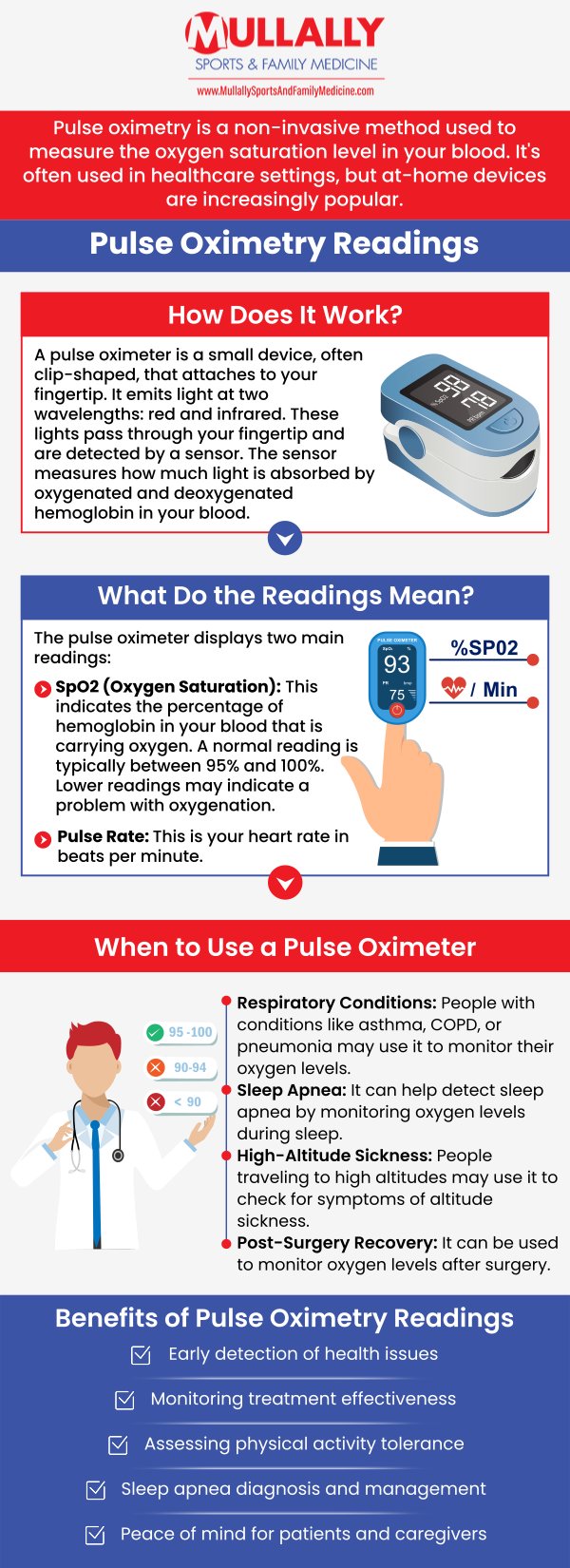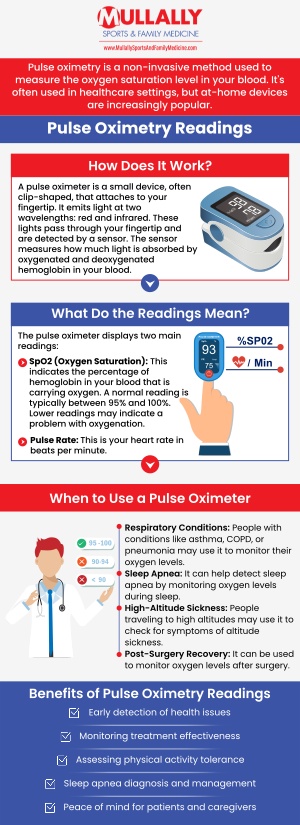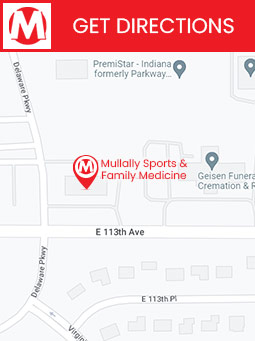Pulse Oximetry Services in Crown Point, IN
Pulse oximetry is a quick, non-invasive procedure that measures the oxygen saturation in your blood, providing vital information for a variety of health conditions. At Mullally Sports & Family Medicine, our professional team offers pulse oximetry testing to monitor your oxygen levels and ensure your respiratory health is optimal. Whether managing respiratory issues or other concerns, we provide personalized care and accurate results. For more information, contact us or schedule an appointment online. We are conveniently located at 11275 Delaware Pkwy Suite A, Crown Point, IN 46307.




Table of Contents:
What is pulse oximetry, and how does it work?
When should I get a pulse oximetry test?
What is a normal pulse oximetry level?
What does a low pulse ox level indicate?
Pulse oximetry is a non-invasive method used to measure the oxygen saturation level of the blood, helping determine how efficiently the body is distributing oxygen. At Mullally Sports and Family Medicine, we frequently use pulse oximetry as part of our comprehensive care for both sports-related concerns and general family medicine.
Pulse oximetry is a non-invasive method used to measure the oxygen saturation level of a person’s blood. This test is typically performed using a small device called a pulse oximeter, which is often clipped onto a patient’s fingertip, earlobe, or toe. The device works by emitting light wavelengths through the skin to assess the amount of oxygen in the hemoglobin in the blood. The pulse oximeter calculates the ratio of oxygenated hemoglobin to total hemoglobin and displays the results as a percentage.
The standard pulse oximetry reading should fall between 95% and 100% for healthy individuals. If the reading falls below 90%, it may indicate hypoxemia, a condition where there is insufficient oxygen in the blood, which can be caused by a variety of conditions, including respiratory or heart problems. This simple and painless test is essential for monitoring oxygen levels, particularly for individuals with chronic lung or heart conditions, as well as for those recovering from surgeries or illnesses that affect respiratory function.
At Mullally Sports and Family Medicine, we are committed to providing timely, efficient, and accurate care. Pulse oximetry is just one of the many tools we use to ensure our patients—whether active athletes or families—receive the best possible assessment and treatment.
We prioritize your respiratory and overall health. A pulse oximetry test is recommended if you experience symptoms like shortness of breath, dizziness, confusion, or chest pain, which may indicate low oxygen levels in the blood. It is also useful for people with chronic conditions such as asthma, chronic obstructive pulmonary disease (COPD), pneumonia, or heart disease, as these conditions can affect oxygen saturation.
If you’re recovering from an illness, especially respiratory or cardiovascular, a pulse oximetry test can help monitor your oxygen levels. Additionally, athletes, especially those training at high altitudes, or individuals at risk of sleep apnea, may benefit from routine pulse oximetry tests to track oxygen saturation during physical activities or sleep. The test is a quick, non-invasive way to ensure your body is getting the oxygen it needs for optimal health and performance. If you’re concerned about your oxygen levels, it’s important to consult a healthcare provider for proper evaluation.
If you have concerns about your breathing, underlying lung or heart conditions, or if you’re an athlete wanting to optimize your respiratory health, Mullally Sports and Family Medicine can determine if a pulse oximetry test is right for you and guide you through all aspects of your care.
Monitoring your oxygen levels is an important part of managing your overall health, especially if you have chronic conditions or are recovering from illness or injury.
A normal pulse oximetry (pulse ox) level typically ranges from 95% to 100%. This indicates that the oxygen levels in your blood are within the expected range, ensuring that your body is receiving enough oxygen for proper function. Pulse oximetry is a non-invasive method used to measure oxygen saturation, providing a quick and convenient way to monitor respiratory health.
Levels below 90% are considered low and may indicate hypoxemia, which suggests that your body isn’t getting enough oxygen. This could be a sign of a medical condition, such as asthma, pneumonia, or other respiratory issues. If your pulse ox reading consistently falls below normal levels, it’s important to seek medical advice for further evaluation and care.
If you’re a patient at Mullally Sports and Family Medicine and notice consistently low oxygen readings, or if you experience symptoms like shortness of breath, chest pain, or confusion, our skilled team is here to provide expert evaluation and care to help you stay healthy and active.
Monitoring your oxygen levels is an important part of maintaining both your overall health and your athletic performance. A low pulse oximetry level, also known as low oxygen saturation, means that the oxygen level in your blood is below normal. For most healthy individuals, a typical pulse oximetry reading ranges from 95% to 100%. Readings below 90% are considered low and may indicate hypoxemia, which suggests that the body is not receiving enough oxygen.
Several factors can contribute to low oxygen levels, including respiratory issues like asthma, pneumonia, or chronic obstructive pulmonary disease (COPD). Heart conditions, anemia, or exposure to high altitudes can also play a role. Symptoms of low oxygen levels can include shortness of breath, rapid heartbeat, confusion, or a bluish tint to the lips or fingertips. Low oxygen levels may impact daily activities, causing fatigue or difficulty in physical performance, and may require immediate medical attention.
At Mullally Sports and Family Medicine, our team is dedicated to helping identify the underlying cause of low oxygen levels and providing the right treatment. Whether you’re managing a chronic condition, recovering from an illness, or striving for peak performance in your sport, your health—and your family’s health—remains our top priority. We also offer lab testing, TB testing, and X-ray services to support your comprehensive healthcare needs. Contact us or schedule an appointment for expert guidance and care. We are conveniently located at 11275 Delaware Pkwy Suite A, Crown Point, IN 46307. We serve clients from Crown Point IN, Winfield IN, Schererville IN, St. John IN, Cedar Lake IN, Munster IN, Lowell IN, DeMotte IN, as well as other Northwest Indiana locations.

Check Out Our 5 Star Reviews


Additional Services You May Like

Additional Services You May Like
- Acute and Chronic Illness
- Annual Wellness Exams
- Concussion Management
- Lab Testing
- Medical Weight Loss Management
- Primary Care
- PRP Injections
- Regenerative Cell Therapy
- Same Day Sick Visits
- Shockwave Lab
- Actinic Keratosis
- Allergy Care
- Botox for Migraine
- Cosmetic Skin Treatment
- Cyst Removal
- Ear Wax Removal
- EKG
- Flu Shots
- Fracture
- Immunizations
- Laceration Repairs
- Moles
- Molluscum Contagiosum
- Mullally Medspa Services
- Nebulizer Treatment
- Nutrition And Exercise Management
- Pregnancy Testing
- Pulse Oximetry
- Respiratory Care
- Skin Tag Removal
- Spirometry
- Strep and Flu
- Surgical Clearance
- TB Testing
- Ultrasound Guided Injections
- Warts
- Women’s Health
- X-Ray
- EPAT Therapy
- EMTT Therapy
- Pediatrics




